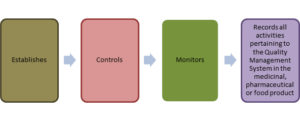GMP regulations require a quality approach to manufacturing, enabling companies to minimize or eliminate instances of contamination, mixups, and errors. This in turn, protects the consumer from purchasing a product which is not effective or even dangerous. Failure of firms to comply with GMP regulations can result in very serious consequences including recall, seizure, fines, and jail time.
GMP regulations address issues including record keeping, personnel qualifications, sanitation, cleanliness, equipment verification, process validation, and complaint handling. Most GMP requirements are very general and open-ended, allowing each manufacturer to decide individually how to best implement the necessary controls. This provides much flexibility, but also requires that the manufacturer interpret the requirements in a manner which makes sense for each individual business.

All guideline follows a few basic principles:
- Manufacturing facilities must maintain a clean and hygienic manufacturing area.
- Manufacturing facilities must maintain controlled environmental conditions in order to prevent cross-contamination from adulterants and allergens that may render the product unsafe for human consumption or use.
- Manufacturing processes must be clearly defined and controlled. All critical processes are validated to ensure consistency and compliance with specifications.
- Manufacturing processes must be controlled, and any changes to the process must be evaluated. Changes that affect the quality of the drug are validated as necessary.
- Instructions and procedures must be written in clear and unambiguous language using good documentation practices.
- Operators must be trained to carry out and document procedures.
- Records must be made, manually or electronically, during manufacture that demonstrate that all the steps required by the defined procedures and instructions were in fact taken and that the quantity and quality of the food or drug was as expected. Deviations must be investigated and documented.
- Records of manufacture (including distribution) that enable the complete history of a batch to be traced must be retained in a comprehensible and accessible form.
- Any distribution of products must minimize any risk to their quality.
A system must be in place for recalling any batch from sale or supply. - Complaints about marketed products must be examined, the causes of quality defects must be investigated, and appropriate measures must be taken with respect to the defective products and to prevent recurrence.
- GMP is also sometimes referred to as “cGMP”. The “c” stands for “current,” reminding manufacturers that they must employ technologies and systems which are up-to-date in order to comply with the regulation. Systems and equipment used to prevent contamination, mixups, and errors, which may have been “top-of-the-line” 20 years ago, may be less than adequate by today’s standards.
Please Check Out Our Website
Here is the List of Products
CHECK MORE ABOUT GMP IN WIKIPEDIA
